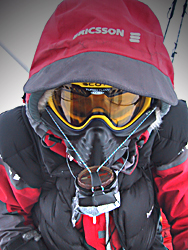Navigation Antarctica
For the South Pole expedition starting at Hercules Inlet it is a good idea to follow a previous expeditions log and try to stay close to the coordinates. That will keep you away from crevasses. Staying around 83 degrees longitude until 84.00 and then close to 80.00 to the South Pole is a good rule of thumb.
Navigation on good days (3 out of 4) is made mainly by the sun. With knowledge of your longitude position and accurate time you will be able to navigate better by the sun and your shadow than a compass.
If you face the South Pole your shadow will fall as follows: At 9.00 AM 45 deg to your right, at 12.00 PM direct towards the Pole and at 3 PM 45 degrees to your left. As earth will do one full rotation (360 degree) in 24 hours, every hour that pass by the sun (and your shadow) will move 15 degrees, Zulu time (GMT) is set for longitude 0. If you are at W15, set the time at Zulu minus 1 hour.
At W30 Zulu minus 2 hours. At W75 Zulu minus 5 hours, which is the time you should use when starting out at Patriot Hill, app. W80. At W80 the shadow will point you towards the South Pole at 12.20 PM if you have set your time to Zulu minus 5 hours. If you start skiing at 9 AM you will know that the shadow will point 45 deg to your right. Follow your shadow or draw a grid with a permanent marker on the front of your skis, drawing lines for 15, 30, 45 and 60 degrees.
As you move closer to the South Pole, the longitudes will come closer to each other and converge at the Pole it self. Thus, you might ski only a kilometer to the right or left and suddenly find your self in a different time zone. Solar navigation will become really tricky, especially in the couple of final days. The really tough part when it comes to SP navigation is whiteout. South Pole whiteout is an incomparable experience and very common in Antarctica. Whiteout conditions will strike one day out of three. As the ice is completely flat for the most part, there is simply nothing but the sun and your own shadow to navigate by. When a whiteout happens those options are gone and you are left almost floating in a white, empty space.
You will have to navigate by compass and check your position on your GPS every hour. The compass for the South Pole should be south-weighted or the needle will dip down towards the North Pole and get stuck. However, even a good compass will play havoc with you due to the Magnetic South Pole nearby. It will spin, refuse to settle and just misbehave in general. This problem is not constant, it is worse in some places than other, and it is a good idea to check often with the GPS when in doubt. If you notice that your distance at the end of the day is shorter than it should have been, especially in whiteout, you can probably blame your compass taking you on detours. Checking with the GPS often will save you travel distance.
People have different favorites when it comes to the placement of the compass. Some mount it on top of one of the skis, other attach it to the ski pole and other again mount it to their facemask. There are even mobile plates to be carried mounted to your stomach and folding out before you with the compass attached on top. No matter your choice it will be a hassle with the needle jumping around with your every body movement.

We really liked the mask-mounted version as it kept the needle right before our eyes at all times. The drawback is that the goggles fog up and you'll end up watching the compass cross-eyed through a tiny patch of clear glass, but that is a problem that affects all varieties of mounting. The head mounted version is simply a wooden square with the compass on top, attached to the mask with rigid steel wire. Isolate the compass base and the attaching wire with duct tape and foam, to prevent the compass from deviating with the metal.
In overcast conditions, you'll be able to navigate by sastrugis and clouds: You take a bearing, head for the spot, check the compass when you come closer and repeat the process. However clouds move around and sastrugi are a pretty dim tool in overcast weather. The compass will still be your main source of waypoint. Make sure it's a good one and check the GPS often.